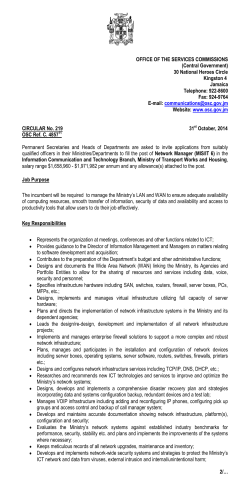
November 2014 Ritsuko SANUKI New and Renewable Energy Division
Ministry of Economy, Trade and Industry Agency of Natural Resources and Energy November 2014 Ritsuko SANUKI New and Renewable Energy Division Agency for Natural Resources and Energy Ministry of Economy, Trade and Industry (METI), Japan Biofuel Policy, Related Guidelines and Regulations Ministry of Economy, Trade and Industry Agency of Natural Resources and Energy Next-generation Vehicle and Fuel Initiative (adopted by METI, May 2007) The development of cellulosic biomass will be key for expanding the use of bioethanol as fuels and lowering dependence on fossil fuels. Cool Earth Innovative Energy Technology Program (adopted by METI, March 2008) BTL (Biomass to Liquid) is regarded as one of the important technologies that significantly contribute to GHG reduction in 2050. The Law Concerning Sophisticated Methods of Energy Supply Structures (basic policies and criteria of judgment developed by METI, 2010) An obligation to use a certain amount of biofuel is imposed on oil refiners. The development of next-generation biofuel technology, whose GHG emission reduction is more than 50% compared to fossil fuel, shall be promoted and introduced in the oil refining industry. Strategic Energy Plan (the newest (4th) version approved by the Cabinet, April 2014) Continues to import biofuels while taking into consideration international situation and technology development of next-generation biofuel. Accelerates to diversify energy resources in the fields of transportation by strategic measures including technology R&D. 2 Ministry of Economy, Trade and Industry Biofuel Target Agency of Natural Resources and Energy The Law Concerning Sophisticated Methods of Energy Supply Structures obligates oil refiners to use a certain amount of bioethanol to be blended with gasoline to produce automotive fuel. The aggregate target amount of bioethanol used by oil refiners for the seven years (from FY2011 through FY2017) of each year shall be as listed in the following chart (crude oil equivalent). The use of bioethanol produced from cellulosic biomass feedstock can be doubled in volume when figuring out achieved target amount. Efforts for promotion of technology development and use of biofuel production from grass and wood cellulose, microalgae, etc. by oil refiners is also encouraged by the Law. Target volume started to increase from 2013 towards 2017 FY2007 FY2010 Voluntary FY2011 FY2012 FY2013 FY2014 FY2015 FY2016 FY2017 Mandatory Unit:1000kl FY2011 FY2012 FY2013 FY2014 FY2015 FY2016 FY2017 as Crude 210 210 260 320 380 440 500 as Ethanol 346 346 428 527 626 725 824 as ETBE 817 817 1011 1244 1478 1711 1944 3 NEDO’s Role in Japan’s Renewable Energy Development Ministry of Economy, Trade and Industry Agency of Natural Resources and Energy NEDO Energy Policy Partnership METI Industry 4 Ministry of Economy, Trade and Industry What is NEDO? Agency of Natural Resources and Energy As Japan’s largest public R&D management organization, Combining the efforts of industry, government and academia, and leveraging established international networks, NEDO promotes research and development that: Contributes to the solution of energy and environmental problems, and Further enhances Japan’s industrial competitiveness. History 1980: Established as the New Energy Development Organization 1988: Reorganized as the New Energy and Industrial Technology Development Organization 2003: Reorganized as an Incorporated Administrative Agency under the Ministry of Economy, Trade and Industry (METI) 148.4 billioneuros yen ininFY2014 Budget : 1.4 billion FY2011 ※Rate: ¥103.93/€ Crossover, Others Research & Industrial Development Technologies (¥138.1 (ICT, Life science, billion) Nanotechnology, Others) Energy and Environment Technologies (Renewable energy, Energy conservation, Others) Personnel Approximately 800 International Project Activities 5 NEDO’s R&D Portfolio in Renewable Energy Ministry of Economy, Trade and Industry Agency of Natural Resources and Energy R&D Budget for New Energy: 28.1 billion Yen Solar PV 9.3 billion yen Higher efficiency, lower cost PV system. Innovative PV technologies Biomass 3.6 billion yen Bioethanol from woody biomass, BTL, biodiesel from microalgae Wind 5.0 billion yen Offshore wind power generation, 7 MW-class wind turbine Ocean 2.5 billion yen Ocean wave power, tidal current power Geothermal 0.5 billion yen Binary power system Hydrogen and Fuel Cell 7.2 billion yen Hydrogen production, transportation and storage, hydrogen infrastructure, SOFC 6 Programs and Schedule of Biofuels R&D in NEDO Ministry of Economy, Trade and Industry Agency of Natural Resources and Energy Continued (FY2013-FY2016) Development in Japan Project to develop base technologies for non-edible plant-derived bioethanol (FY2007-FY2012) B : Bioethanol & System Project to dev. integrated prod sys for ethanol derived from non-edible plant (FY2009FY2013) R&D projects about Algal Biofuels FY2007 To Be Continued C : Next-Gen Biofuels Project to develop next-generation biofuels other than ethanol (FY2010-FY2016) FY2010 FY2020 FY2014 International Demonstration Project Bioethanol Production from Cassava Pulp Bioethanol Production from Bagasse 7 etc. Commercialization and Demonstration overseas Energy Security Technology Development A : Fundamental R&D Ministry of Economy, Trade and Industry Biofuels Development Challenges Agency of Natural Resources and Energy ○ Currently fuels in transportation sector is almost totally dependent on fossil fuels. It is important and urgent issue to further ensure energy security and diversify fuel sources by introducing biofuels. <Sugar cane, Corn, etc. (1 st Generation)> ○Biofuels produced from edible farm goods by fermentation technology. The market is already established and widely distributed centering around main producer country Brazil. On the other hand, as feedstock is edible agri product, it is necessary to develop technology to avoid competing with food resources. <Woody plants, Herbaceous plants(Cellulosic Bioethanol: 2nd Generation)> ○Biofuels produced from cellulosic biomass by fermentation technology. Aiming to create a market around 2020, currently making efforts to establish integrated system for low-cost production which does not compete with food and avoid environmental problems. <Microalgae, BTL (3rd or Next Generation)> ○In addition to urgent need to tackle by accumulated technology of fermentation for a long time, in order to ensure further energy security and expand the market at around 2030, conducting R&D on utilization of microalgae biomass and BTL (Biomass to Liquid) technology which can make maximum use of feedstock, etc., to develop high-efficient and high-yield biofuel production technology. Cellulosic Bioethanol Biomass Pretreat ment Sacccharificat. Condens. Ferment. Dehydrat. Ethanol Microalgae Cultivation Condens., Dehydrat. Extract., Purificat. Biofuels ↑ Change in biofuel prices by introducing technological innovation 8 Ministry of Economy, Trade and Industry NEDO’s Current R&D Project on Next-Gen Biofuels Agency of Natural Resources and Energy “Strategic Development of Next-Generation Bioenergy Utilization Technology” Aim to further broaden and diversify biofuel resources which do not compete with food supplies by conducting technology R&D on microalgal biofuel production and biomass gasification and liquefaction. ○ identify and develop high- oil producing strain ○ high-efficiency culture, condensation, extraction technology ○ low-cost gas refining technology ○ high-efficiency synthesis/reforming technology in low pressure condition, etc. 濃縮・脱水 ~ ~ ~ 乾燥 Microalgae Culture Condens., Dehydrat. Cellulosic Biomass Gasification Refine Compress, Synthesis, Reforming 抽出 精製・改質 Extraction, Purification Refine, Separation Biofuels Biofuels 9 Ministry of Economy, Trade and Industry Programs and Schedule of Next-gen Biofuels R&D H24Fy 2012 Strategic Development of Next-generation Bioenergy Utilization Technology Technology Development H25Fy 2013 H26Fy 2014 H27Fy 2015 H28Fy 2016 H29Fy 2017 H30Fy 2018 Agency of Natural Resources and Energy H31Fy 2019 H32Fy 2020 H37Fy 2025 algal biofuels Selection & Breeding Open huge cultivation Harvesting Improvement of Oil content Demonstration (Internal) > 1000 ㎡ “From cultivation to fuel production” Establishment of consistent process Demonstration (outside) > 5000 ㎡ Technology Development Gasification Hydro thermal liquefaction FT synthesis to bio-jet, bio-diesel scale-up for commercial use BTL Current problem is “securing ofMRJ materials” with cheaply in large quantities Demonstration (Internal) scale-up for commercial use 10 Ministry of Economy, Trade and Industry Major R&D Projects regarding Algal Biofuels Algae Species 1 Euglena 2 Pseudococcomyxa sp. KJ 3 Chlamydomonas orbicularis Tai-04 Lipids (#Carbon) Cultivation waxmonoester (C14) Hitachi Denso Glyceride (C16~18) Fistulifera solaris 4 JPCC DA0580 Agency of Natural Resources and Energy Scale (m2) raceway (25) raceway Strain Selection Euglena Oil Refiner JX Chuo Univ Idemitsu Kobe Univ - J-Power roundpool (10) Tokyo U of A&T - NeoMorgan - Miyazaki Univ Cosmo DIC (60) raceway (50) Botryococcus 5 (improved strain) hydrocarbon (C30~32) IHI square pond (100) 6 Thraustochytrids Glyceride (C16~18) Biomaterial in Tokyo (30 L jar Fermentor) 11 Ministry of Economy, Trade and Industry R&D project 1: Euglena Agency of Natural Resources and Energy R&D Theme In this project, technology development for improving the productivity and oil content of Euglena, establishment of ideal culture conditions and basic experiments on mass culture and oil production or analysis of the metabolic pathway for paramylon accumulation, which is a precursor of oil production in Euglena, along with the suitability of its oil as jet fuel will be investigated. Improvement in productivity of Euglena and its oil content Sunlight CO2 Water Culture CondensationOil extraction Water (Recycled) Species Euglena Scale raceway (25m2) Lipids wax-monoester Company JX, Euglena, Hitachi, Keio Univ. Euglena oil Fuel (HydrogenationIs omerization) Extraction residue (Reuse under investigation) Drying Extraction Jet fuel 12 Ministry of Economy, Trade and Industry R&D project 2 : Pseudococcomyxa Agency of Natural Resources and Energy R&D Theme The objectives of this R&D are development of automatic cultivation system which can maintain the oil rich microalgae as the dominant species more than two months, development of membrane filtration system for 100-fold cell concentration and development of catalytic conversion technology from bio-crude oil to hydrotreated biofuel. Species Pseudococcomyxa sp. KJ Scale raceway (30m2) Lipids TGA Company Denso, Chuo Univ, Kubota, Idemitsu Oil Rich Microalgae Fertilizer 肥料 Recycle of Water Raceway Pond Polymeric hollow-fiber membrane Pre-Treatment Hydro-treatment Ceramic membrane BioCrude Bio Fuel Automatic Cultivation Harvesting Extraction 13 Ministry of Economy, Trade and Industry R&D project 3: Chlamydomonas orbicularis Agency of Natural Resources and Energy R&D Theme Novel cultivation system is developed to maximize oil productivity by realizing both high cell density culture and high oil content in the cell. Mass cultivation is also performed with 50 m2 pond to develop the optimized system. Economics, material and energy balance are estimated based on the cultivation data. Construction of high-oil producing green alga through metabolic engineering is intended by the development of genomic transformation of C. orbicularis. Species Chlamydomonas orbicularis Tai04 Scale raceway (50m2) Lipids TGA Company DIC, Kobe Univ, Nat’l Inst of Basic Biology Oil Under seawater environment, to form the oil droplets after the nitrogen source consumption 14 Ministry of Economy, Trade and Industry R&D project 4 : Fistulifera solaris Agency of Natural Resources and Energy R&D Theme This project aims to create new basic system for green oil production throughout the year using mesophilic and cryophilic oil producing diatoms. Based on the considerations of four factors described above, the entire process for green oil production will be designed to improve the EPR (Energy Payback Ratio) and the costperformance. Furthermore, the metabolic engineering by genetic engineering will be performed to enhance the oil productivity in candidate strains. Species Fistulifera solaris JPCC DA0580 Scale round-pool (50m2) Lipids TGA Company J-Power, JGC, Tokyo U of A&T TGA Oil content (max): 60 wt% (C16:0, C16:1) growth rate: > 1/day 15 Ministry of Economy, Trade and Industry R&D project 5: High-yield Botryococcus Agency of Natural Resources and Energy R&D Theme To produce algae oil at low cost and with minimal energy, it is necessary to increase cell size, optimize density and reduce byproducts. Also, development of recombinant DNA technology for algae is very important for a breeding method. In this R&D, these traits are being added for high-speed cultivation of Botryococcus to improve economic efficiency and the energy balance by constructing a large-scale cultivation system. Species Botryococcus (improved strain) Scale Square open pond (100m2) Lipids hydrocarbon Company IHI, Neo Morgan Lab, Kobe Univ. Resent Topics: leading to “Energy-saving harvest” particle size was increased (left: original strain , others: improved strains) Flotation ratio was improved (left: original strain , others: improved strains) 16 Ministry of Economy, Trade and Industry R&D project 6: Thraustochytrids Agency of Natural Resources and Energy R&D Theme This project aims at developing a production system with thraustochytrids that are genetically modified to utilize lignocellulose-derived (corn fiber, rice straw, etc.) sugar solutions efficiently. Other areas such as production cost, methods of oil extraction, fuel quality, and energy conversion will also be examined. Species Thraustochytrids Scale reacter (30L) Lipids TGA Company Biomaterial in Tokyo Co., Ltd. Miyazaki Univ Pentose Hexose Hexose transporter Pentose transporter 5/7 L jar fermentor Saccharified lignocellulose Hexose metabolic system Pentose metabolic system 30 L jar fermentor 1,000 L fermentor Develop high-density cultivation system 2. Assessment of cultivation methods Glycolytic pathway Acetyl CoA Pentose phosphate pathway Oil production system COOH Oil Thraustochytrids Cell membrane ・ Genetic modification to allow pentose metabolism (addition of portion in red) 1.Generation of saccharified biomass-compatible thraustochytrids strain COOH ・ Analysis of oils made by thraustochytrids ・ Evaluation of industrial- scale production methods 3. Evaluation of fuel suitability 17 R&D project 7: Biomass to Liquid by MHI & Toyama Univ Ministry of Economy, Trade and Industry Agency of Natural Resources and Energy R&D Theme The commercialization of biomass to liquid (BTL) technology requires not only development of stand alone processes but a total system solution. This R&D targets the development of an innovative biojet fuel production system. This R&D focuses on the development of entrained flow gasifiers suitable for BTL and FT synthesis catalysts for biojet fuel with high selectivity and durability. This development is aimed at improving efficiency and reducing the cost of BTL systems, which are challenges in biomass energy consumption. Biomass gasification process Biofuel synthesis process Off-gas Cooling and refinement Biomass FT synthesis fuel Jet fuel Pretreatment FT synthesis Biomass gasification Waxing Separation Hydrogen ation Distill ation Kerosene Light oil 18 Technology Steadily Developing … Ministry of Economy, Trade and Industry Agency of Natural Resources and Energy ... Advancing step by step, METI/NEDO have been tackling various challenges with the spirit of “Slow but Steady Win the Race”. Above all, crucial to establish a solid, large-scale cultivation system to prove its feasibility – before moving into whole integrated production system; Simultaneously further promote development of cost/energy-efficient process technology; Once proved, speeding up decision making and stepping forward to next stage is absolutely necessary!!! 19 Ministry of Economy, Trade and Industry Agency of Natural Resources and Energy November 2014 Ritsuko SANUKI New and Renewable Energy Division Agency for Natural Resources and Energy Ministry of Economy, Trade and Industry (METI), Japan
© Copyright 2025



















